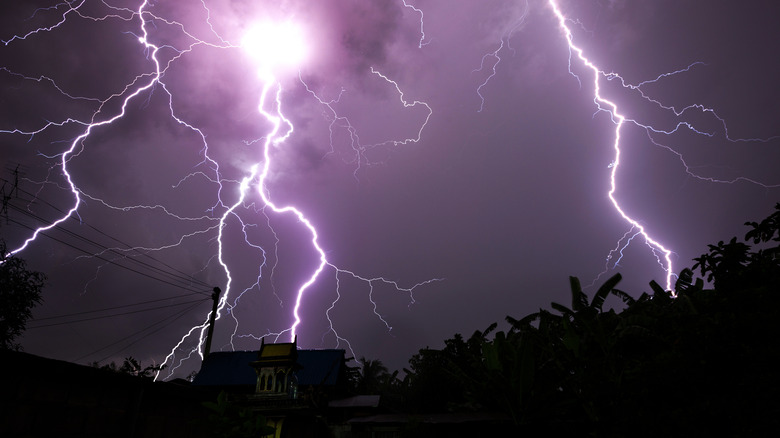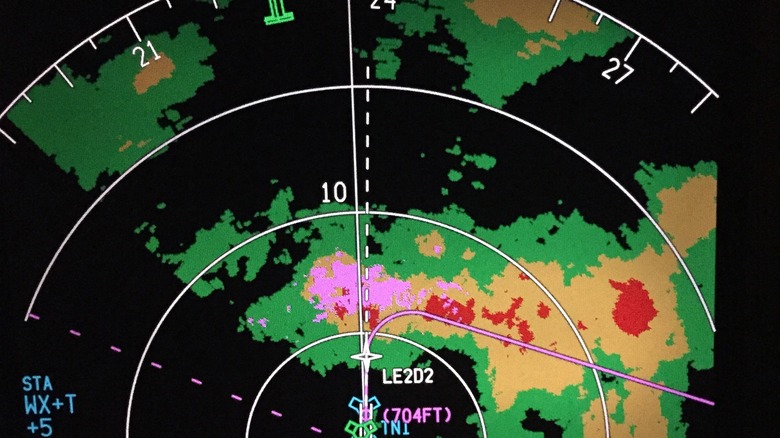The Lightning Tech That Hopes To Save Lives
Being struck by lightning can be a horrifying notion, but there's a type of tech that can help make calamitous storms seem less scary than usual. Nature has a way of letting us know who's in charge, and a single lightning strike can easily force anyone to seek shelter ASAP. Fortunately, weather prediction technology has evolved over the years, with satellites now serving as humanity's constant eye in the sky to detect any suspicious anomalies. The National Oceanic and Atmospheric Administration (NOAA) is among the groups that help prevent civilians from becoming victims of such weather hazards.
By using a variety of weather-related tech, NOAA has constantly found ways of giving everyone a head-start in avoiding danger. However, the problem with lightning strikes lies in their unpredictability. People have a slim yet very real chance of having a life-threatening encounter with lightning just as much as being crushed by a random rocket from space. That's something NOAA is trying to prevent with its innovative lightning tech, but does it show any promise or is it still too early to tell?
Lightning tech that's shocking ... in a good way
It's quite tricky to predict lightning before it strikes simply because it happens almost instantaneously, but NOAA's experimenting with a new type of tech to tackle just that. Meet LightningCast: a weather-predicting prototype that helps mitigate the issue by forecasting lightning at least an hour before it even happens, according to the NOAA. It utilizes visual cues that change in color to show varying degrees of probability and easily portray the likelihood of lightning strikes within a specific area. While lightning-related deaths might seem rare, the National Weather Service reports 14 cases already in 2022 alone.
With the help of LightningCast, however, the National Weather Service was able to avoid similar cases from happening during the planned World Games in Alabama. After using it to detect a potential lightning threat within the surrounding area, the NWS helped postpone an event that could've put thousands of attendees at risk of getting lethally shocked (via FOX Weather). Although the technology is still under review, LightningCast has reportedly been met with a "favorable" reception by forecasters so far, and some are hopeful it receives mass adoption soon. The thing is, some forms of technology can be lethal just by giving us a false sense of security, which begs the question, can the same be said for LightningCast?
How accurate is LightningCast?
For those wondering how exactly LightningCast works, it's basically an application that utilizes machine learning along with multiple inputs from various satellites (via NOAA). It then uses this information to calculate the probability of lightning strikes within a specific area. LightningCast alone doesn't do all the work though, rather, it's meant as a Decision Support Service (DSS) tool to aid forecasters. Once the program's readings go above 50% probability, forecasters can better ascertain when to issue warnings to areas that are dangerously susceptible to such calamities. Compared to a tool that predicts lightning probabilities based on storm movement, LightningCast displays a more easy-to-read format, with its usability being described as "fantastic."
According to a blog from NOAA's Experimental Warning Program, LightningCast's utility extends to its graphical representation, given that it's said to "show actionable probabilities that users can understand." This makes the program a "time saver" in terms of forecasting possible lightning strikes. What gives NOAA more confidence in LightningCast's readings is its ability to give "upwards of 40 minutes of lead time," allowing users to have ample time for decisive action and preparation. Despite still being in an experimental phase, LightningCast is already showing great promise, but for now, only time will tell how many lives it could help save.


